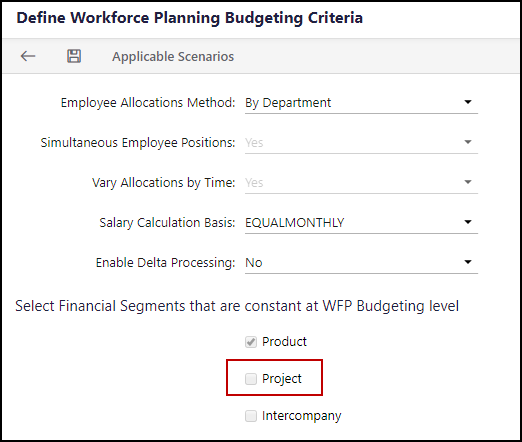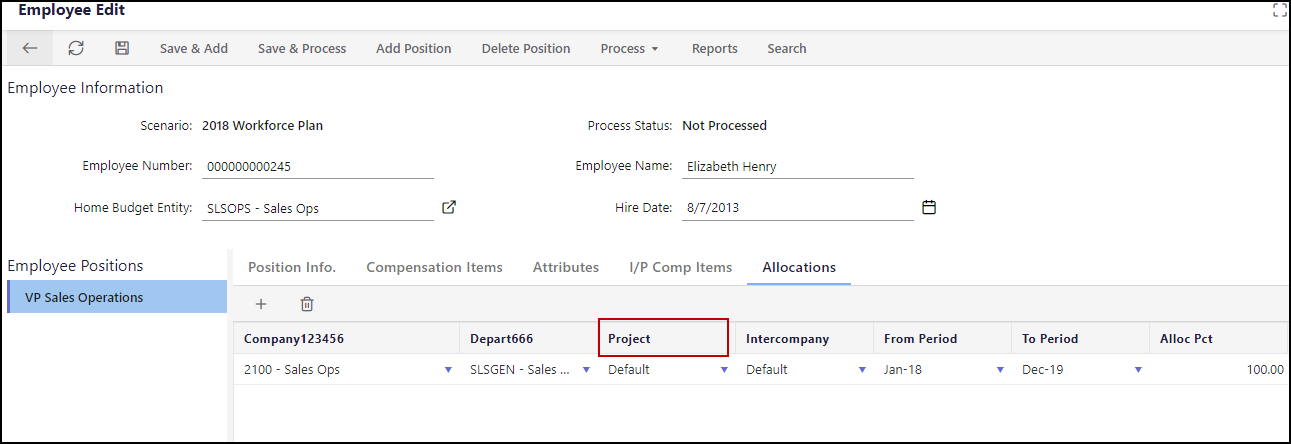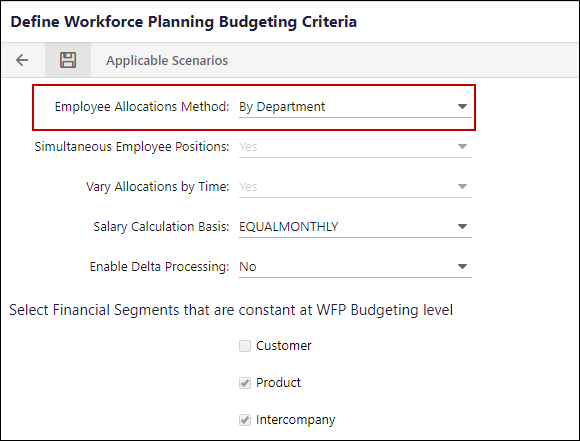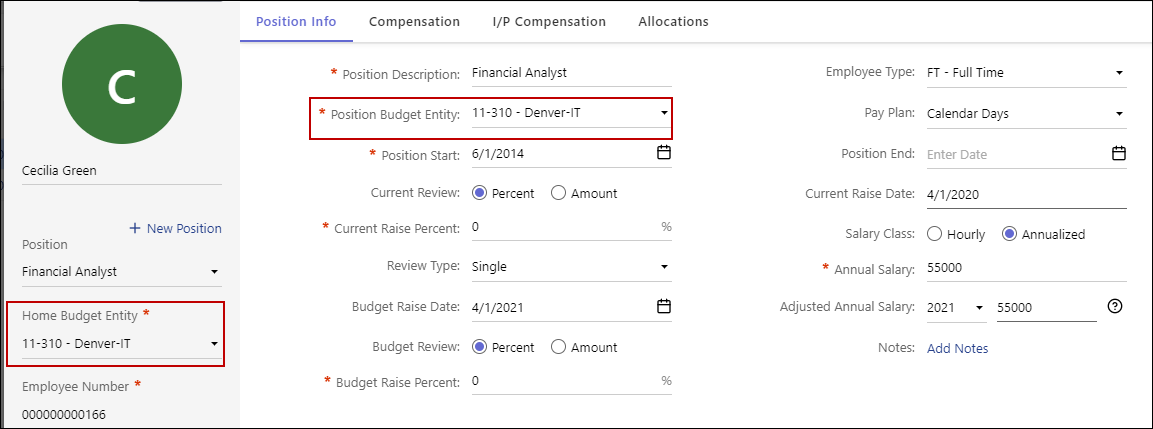- 4 Minutes to read
- Print
- DarkLight
- PDF
Configuring Workforce Planning
- 4 Minutes to read
- Print
- DarkLight
- PDF
Set up the Structured Planning application by defining the structure and configuring the tasks mentioned in the Structured Planning Admin Guide. In addition to this, you must configure the following tasks to set up Workforce Planning:
Define Workforce Planning Budgeting Criteria
Define Workforce Planning Budgeting Criteria
You can configure your budgeting criteria to drive the efficacy of your budget.
You can define the budget criteria on the Define Workforce Planning Budgeting Criteria page. The budget criteria directly correlates to the templates you will set up. End users will use these templates to input budgeting data. You can define various Workforce Planning budgeting criteria such as allocations, employee positions, and salary calculations. The way you define the criteria on this page will impact the way you perform Workforce Budgeting.
You can access the Define Workforce Planning Budgeting Criteria page by going to Maintenance > Configuration Task List > Define Workforce Planning Budgeting Criteria.
Field Descriptions
Employee Allocations Method- This list box allows you to allocate employee expenses based on department or compensation items. Select one of the following options:
By Department - To allocate all compensation items. Salary and all benefits are allocated for an employee.
By Compensation Item - To allocate compensation items separately. Selecting this option opens Account selection and association.
This selection affects the available options and allocation fields under the Allocations tab on the Employee Add or Employee Edit page.
Simultaneous Employee Positions - This list box allows you to enable two or more positions for an employee. To allow an employee to hold multiple positions at the same time, select Yes.
If you select No, the work cycle of the existing employee position must first reach the end date. Only after that, the employee will be able to start a new position.
For example, an employee can be the Dean of a Department and also the Program Director if you select the Yes option for the Simultaneous Employee Positions list box.
Whereas if you select No for the Simultaneous Employee Positions list box, the Dean position must end first. Only after the Dean position reaches the end date, the employee will be able to start the new Program Director position.
You can open or disable simultaneous employee positions when employee data is not uploaded to the Planful system.
Vary Allocations by Time - This list box allows you to allocate an employee by period; select Yes to do so.
For example, if an employee is working on multiple projects the first half of the year (Jan’20 – Jun’20), Salary and Benefits have to be budgeted to project A and for the second half of the year (Jul’20 – Dec’20), Salary and Benefits need to be budgeted to project B. This means that you are varying employee allocations by time.
Salary Calculation Basis - This list box allows you to specify the spread method used to distribute compensation dollars. You can apply pay plans to override the default spread, if required. Select one of the following options:
Workdays - To distribute compensation dollars over workdays.
Equal Monthly - To distribute compensation dollars equally every month.
Calendar Days - To distribute compensation dollars based on calendar days.
Note:In order for a new pay plan to override the selection made here, Salary Calculation Basis must be set to Equal Monthly.
Enable Delta Processing - This list box allows you to automatically process all employees that have not been processed or employees with a Not Processed status (under the Process Status column) in the Employees roster. Select Yes to do so and select applicable scenarios from the Applicable Scenarios option.
Workforce Budgeting Constants - The segments under the Select Financial Segments that are constant at WFP Budgeting level option are those segments that have not been included in the budget entity or financial account segments. You can select the segments that remain constant throughout the workforce-budgeting process.
Select Financial Segments that are a constant at the Workforce Budgeting level, if you have a segment that need not be considered for Workforce budgeting. For example, if you do not budget employee expenses at the Product Line level (assuming the Common COA defined is Company, Department, Account, and Product Line in the application), you must then select this segment as a constant for Workforce Budgeting.
If you do not select any segment, it will appear in the Allocations table located on the Employee Add/Edit page as shown in the following images.


Understanding Employee Allocations
You can use the employee allocation functionality to allocate or distribute employees amongst budget entities/segments (Department, Company, and more.) and compensation items. Use the Employee Allocations Method list box to do so.

Allocate Employees by Department
To allocate employees by department, select the By Department option from the Employee Allocations Method list box. When you select this option, the Compensation Item and Account columns are not available on the Employee Add/Edit Allocations page. In this case, the Department is a segment and allocations are based on a combination of the Company/Department segments.
You do not need to have a department segment to allocate by department. The columns displayed on the Employee Add/Edit page under the Allocations tab make up the budget entity and the financial segments/constants.
The Company column is populated based on the selection of the Position Info tab on the Employee Add/Edit page.

Notice that the Company is 11 - Denver and the Department is 310-IT.

Allocate by Compensation Items
To allocate employees by compensation items, select the By Compensation Item from the Employee Allocations Method list box. When you select this option, you can allocate compensation items separately and in more detail as additional selections will be available (in the Compensation Item and Accounts column) on the Employee Add/Edit page under the Allocations tab. Although using the allocate By Compensation Item method offers more granular control, this method also requires more maintenance.
Workforce Reporting Area
Configure the Workforce Reporting Area. This represents the Workforce Reporting cube and associated dimensions. From the Configuration Task List page, click Define Reporting Areas to expand the topic and then click Workforce.

